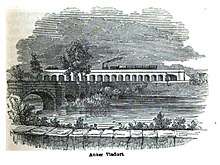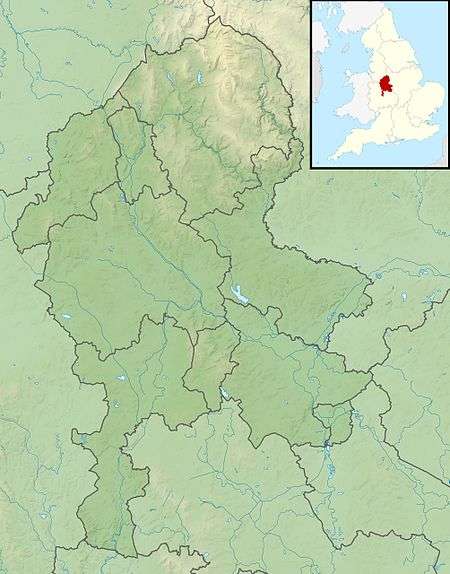Bolehall Viaduct
Bolehall Viaduct (formerly the Anker Viaduct) is a 807 feet (246 m) viaduct on the former Birmingham and Derby Junction Railway line near Tamworth, Staffordshire, England now part of the Cross Country Route.
Bolehall Viaduct | |
|---|---|
 Anker Viaduct from the Midland Counties' Railway Companion of 1840 | |
| Coordinates | 52°37′50.8″N 1°41′10.5″W |
| Carries | Cross Country Route |
| Crosses | River Anker |
| Locale | Tamworth, Staffordshire |
| Official name | Bolehall Viaduct |
| Other name(s) | Anker Viaduct |
| Maintained by | Network Rail |
| Heritage status | Grade II listed [1] |
| Characteristics | |
| Total length | 807 ft (246 m) |
| History | |
| Opened | 1839 |
 Bolehall Viaduct Location in England  Bolehall Viaduct Bolehall Viaduct (Staffordshire) | |
Construction
It was designed by Robert Stephenson and G. Bidder. The Birmingham and Derby Junction Railway issued tenders for the contract in May 1837[2] and the contracts were let in August 1837.[3] It was built in rusticated ashlar stone with 19 arches to bridge the River Anker and was originally known as the Anker Viaduct. By February 1839 the construction was completed and the ballasting was being prepared for the permanent way. [4] The first engine traversed the viaduct on 1 July 1839 and the first train on 6 July. Passenger services began on 12 August 1839.[5]
References
| Wikimedia Commons has media related to Bolehall Viaduct. |
- Historic England, "Bolehall Viaduct (1293304)", National Heritage List for England, retrieved 30 October 2017
- "Birmingham and Derby Junction Railway. Contract for Works". Birmingham Journal. England. 20 May 1837. Retrieved 29 October 2017 – via British Newspaper Archive.
- "Birmingham and Derby Junction Railway". Globe. England. 8 September 1837. Retrieved 29 October 2017 – via British Newspaper Archive.
- "Birmingham and Derby Junction Railway". Sheffield Iris. England. 19 February 1839. Retrieved 29 October 2017 – via British Newspaper Archive.
- "The Birmingham and Derby junction railway". Worcester Journal. England. 15 August 1839. Retrieved 25 October 2017 – via British Newspaper Archive.